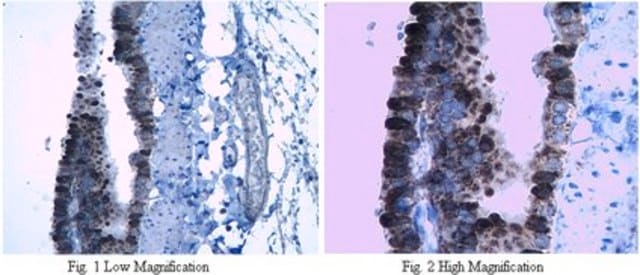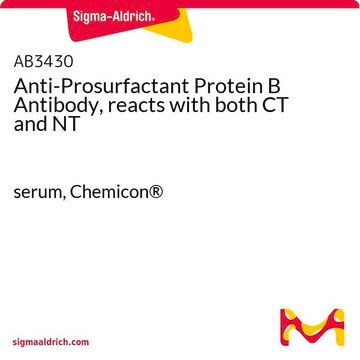07-614
Anti-Surfactant Protein B Antibody
serum, Upstate®
Sign Into View Organizational & Contract Pricing
All Photos(1)
About This Item
UNSPSC Code:
12352203
eCl@ss:
32160702
NACRES:
NA.41
Recommended Products
biological source
rabbit
Quality Level
antibody form
serum
antibody product type
primary antibodies
clone
polyclonal
species reactivity
mouse, human
manufacturer/tradename
Upstate®
technique(s)
immunohistochemistry: suitable
western blot: suitable
isotype
IgG
UniProt accession no.
shipped in
dry ice
target post-translational modification
unmodified
Gene Information
mouse ... Sftpd(20390)
Specificity
Surfactant Protein B
Immunogen
Purified human surfactant protein B
Application
Anti-Surfactant Protein B Antibody is an antibody against Surfactant Protein B for use in IH & WB.
Research Category
Metabolism
Metabolism
Research Sub Category
Ion & Transport Channels
Ion & Transport Channels
Quality
routinely evaluated by immunoblot on human bronchiolar lavage fluid.
Target description
8kDa
Physical form
Serum
rabbit antiserum containing 0.05% sodium azide before the addition of glycerol to 30%
Storage and Stability
2 years at -20°C
Legal Information
UPSTATE is a registered trademark of Merck KGaA, Darmstadt, Germany
Disclaimer
Unless otherwise stated in our catalog or other company documentation accompanying the product(s), our products are intended for research use only and are not to be used for any other purpose, which includes but is not limited to, unauthorized commercial uses, in vitro diagnostic uses, ex vivo or in vivo therapeutic uses or any type of consumption or application to humans or animals.
Not finding the right product?
Try our Product Selector Tool.
Storage Class Code
12 - Non Combustible Liquids
WGK
WGK 1
Flash Point(F)
Not applicable
Flash Point(C)
Not applicable
Certificates of Analysis (COA)
Search for Certificates of Analysis (COA) by entering the products Lot/Batch Number. Lot and Batch Numbers can be found on a product’s label following the words ‘Lot’ or ‘Batch’.
Already Own This Product?
Find documentation for the products that you have recently purchased in the Document Library.
Ralph Epaud et al.
American journal of respiratory cell and molecular biology, 28(3), 373-378 (2003-02-21)
Transgenic mice, in which the level of surfactant protein (SP)-B mature peptide varied 5.6-fold between SP-B(+/-) and SP-B-overexpressing lines (SP-B+/+/+), were used to test the hypothesis that SP-B protects against endotoxin-induced lung inflammation. Intratracheal administration of endotoxin resulted in significantly
Yan Liu et al.
Molecular reproduction and development, 84(8), 668-674 (2017-05-18)
Respiratory distress is a major cause of mortality in cloned neonatal animals, but its pathogenesis remains poorly understood. Here, we used necropsy and histology procedures to evaluate the lungs of cloned neonatal bovines dying of respiratory distress, finding incomplete lung
L M Nogee et al.
American journal of respiratory and critical care medicine, 161(3 Pt 1), 973-981 (2000-03-11)
Inability to produce surfactant protein B (SP-B) causes fatal neonatal respiratory disease. A frame-shift mutation (121ins2) is the predominant but not exclusive cause of disease. To determine the range of mechanisms responsible for SP-B deficiency, both alleles from 32 affected
Lili Zhang et al.
Neoplasia (New York, N.Y.), 20(2), 207-217 (2018-01-15)
Risk stratification using molecular features could potentially help distinguish indolent from aggressive prostate cancer (PCa). Mutations in isocitrate dehydrogenase (IDH) acquire an abnormal enzymatic activity, resulting in the production of 2-hydroxyglutarate and alterations in cellular metabolism, histone modification, and DNA
Surfactant chemical composition and biophysical activity in acute respiratory distress syndrome.
Gregory, T J, et al.
The Journal of Clinical Investigation, 88, 1976-1981 (1991)
Our team of scientists has experience in all areas of research including Life Science, Material Science, Chemical Synthesis, Chromatography, Analytical and many others.
Contact Technical Service








